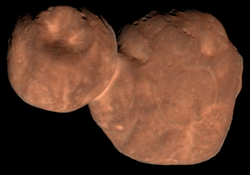Innovative Satellite Technology Demonstration-1
Innovative Satellite Technology Demonstration-1 is a mission to demonstrate various experimental devices and technology in space. It is the first flight in the Innovative Satellite Technology Demonstration Program, managed by the JAXA Research and Development Directorate. The mission includes several spacecraft, the largest being RAPIS-1, along with six smaller satellites. It was successfully launched on 18 January 2019.[1]
Overview
Innovative Satellite Technology Demonstration-1 is a mission purposed to provide a flight opportunity for technology and ideas put forward by universities and private companies. Payloads flown on the mission will be tested in space for a year, and the operational data gained will be given to the developers. According to JAXA, the goal of this program is to test high risk, innovative technology that will lead to the space industry gaining competitiveness in the international field.[2] The call for proposals was announced in 2015, and selection results were announced in February 2016.[3] A total of 14 projects were selected; however a proposal by IHI Corporation, the "Demonstration experiment of a innovative ship information receiving system"[3] was later dropped, making the number of projects reaching space 13. Seven projects will be tested on board the satellite RAPIS-1, either as parts or components. Three projects are flying as microsatellites, and three more as CubeSats. The Innovative Satellite Technology Demonstration-1 marked the first multi-satellite launch by Epsilon rocket.[4]
| Project | Type | Agency |
|---|---|---|
| NBFPGA | Part | NEC Corporation |
| HXTX / XMGA | Component | Keio University |
| ? | Component | IHI Corporation |
| GPRCS | Component | J-spacesystems |
| SPM | Component | J-spacesystems |
| DLAS | Component | Tokyo Institute of Technology |
| TMSAP | Component | JAXA |
| Fireant | Component | Chubu University |
| MicroDragon | Microsatellite | Keio University |
| RISESAT | Microsatellite | Tohoku University |
| ALE-1 | Microsatellite | ALE Co., Ltd. |
| OrigamiSat-1 | CubeSat | Tokyo Institute of Technology |
| Aoba VELOX-IV | CubeSat | Kyushu Institute of Technology |
| NEXUS | CubeSat | Nihon University |
RAPIS-1
| Mission type | Technology demonstrator |
|---|---|
| Operator | Axelspace / JAXA |
| COSPAR ID | 2019-003A |
| SATCAT no. | 43932 |
| Website | www |
| Spacecraft properties | |
| Manufacturer | Axelspace |
| Launch mass | 200.5 kg (442 lb)[2] |
| Start of mission | |
| Launch date | 18 January 2019, 00:50:20 UTC |
| Rocket | Epsilon |
| Launch site | Uchinoura |
| End of mission | |
| Deactivated | 23 June 2020[5] |
| Orbital parameters | |
| Reference system | Geocentric |
| Regime | Sun-synchronous |
RAPIS-1 (RAPid Innovative payload demonstration Satellite 1) is a satellite within Innovative Satellite Technology Demonstration-1 that will demonstrate selected projects as either parts or components. Of the 13 projects, 7 will be demonstrated on board RAPIS-1. The satellite was developed by Axelspace Corporation, a startup company focusing on small satellite development and application, and is the largest satellite to date the company developed.[6] According to reports by Japanese media, the satellite was the first case for JAXA to contract a private company to manage the entirety of a satellite, from its development to its operation.[7]
Payload
- The NanoBridge based Field Programmable Gate Array (NBFPGA) is a compact FPGA using atomic switches. NBFPGA was developed by NEC Corporation.
- High data rate X-band Transmitter (HXTX) / X-band Middle Gain Antenna (XMGA) was developed by Keio University.
- The Green Propellant Reaction Control System (GPRCS) is a propulsion system to demonstrate the use of less-toxic fuel. GPRCS was developed by Japan Space Systems, a space agency under the Japanese Ministry of Economy, Trade and Industry.
- The Space Particle Monitor (SPM) was developed by Japan Space Systems, and is an orbital environment monitor using commercial-off-the-shelf products. Most orbital measuring instruments thus far were designed for large satellites and are bulky and costly, while SPM is small, light, and inexpensive, making it suitable for small satellites to carry.[8] According to Japan Space Systems, by monitoring radiation SPM will help determine the cause of satellite failures.[9]
- The Deep Learning Attitude Sensor (DLAS) is a dual use Earth sensor and star tracker applying deep learning.[10] Images taken will be analyzed by deep learning, and the results will be sent to ground stations, effectively conducting edge computing in space.[11] DLAS was developed by Tokyo Institute of Technology (TITech), and is aiming for commercialization.[12][10]
- The Thin Membrane Solar Array Paddle (TMSAP) is a thin-film solar cell that will be unfolded in space. It consists of five panels, each with one-fifths the weight of traditional honeycomb rigid panels. TMSAP was developed by JAXA.
- Fireant (Miniature Spaceborne GNSS Receiver) was developed by Chubu University.
MicroDragon
MicroDragon is a microsatellite proposal submitted by Takashi Maeno of Keio University.[3]
RISESAT
Rapid International Scientific Experiment Satellite, or RISESAT is a microsatellite developed by Tohoku University. It is equipped with scientific instruments that were selected on an international scale.[13] The project RISESAT was selected for the Innovative Satellite Technology Demonstration Program to demonstrate highly precise attitude control and high resolution multispectral observation technology. RISESAT's high resolution multispectral camera will be capable of measuring the growth rate and health of crops from space.[14] RISESAT's remote sensing instrument, High Precision Telescope (HPT) utilizes a liquid crystal tunable filter.[15] The project was previously called Hodoyoshi 2.
ALE-1
ALE-1, also known as ALEe, is a microsatellite for demonstrating the creation of artificial shooting stars. Built and operated by ALE Co., Ltd., it is the company's first satellite. ALE-1 is equipped with a DOM2500 deorbit mechanism manufactured by Nakashimada Engineering Works, Ltd.[16][17] The DOM2500 is a membrane sail 2.5 m × 2.5 m large when deployed, and will be used by ALE-1 to lower its altitude to less than 400 km, the optimal altitude to conduct its main mission.[18]
OrigamiSat-1
OrigamiSat-1 is a 3U CubeSat demonstrating the deployment of large structures from a small, folded state. After being launched to an altitude of 500 km, OrigamiSat-1 will descend down to 400 km, where it will deploy a 1 square meter membrane.[19] It was developed by Tokyo Institute of Technology.
Aoba VELOX-IV
Aoba VELOX-IV is a 2U CubeSat equipped with a low-light camera. It was jointly developed by Kyushu Institute of Technology in Japan and Nanyang Technological University (NTU) of Singapore. The pulsed plasma thrusters developed by NTU gives the CubeSat maneuvering capabilities, a necessity for a future lunar mission, as the Moon's irregular gravity field requires orbiters to perform orbit maintenance to extend its mission lifetime.[20] It has a design lifetime of 12 months in low Earth orbit.[21]
NEXUS
NEXUS, short for NExt generation X Unique Satellite is a 1U CubeSat developed by Nihon University. An amateur radio satellite, it is equipped with a transmitter with half the power consumption and a data transmission rate per second 32 times larger than a traditional amateur radio transmitter. NEXUS will demonstrate packet radio in space.[22]
See also
References
- "Launch Success, The Innovative Satellite Technology Demonstoration-1 aboard Epsilon-4" (Press release). JAXA. January 18, 2019. Retrieved 2019-01-18.
- "革新的衛星技術実証 1号機について" (PDF) (in Japanese). JAXA. 19 December 2018. Retrieved 2019-01-18.
- "「革新的衛星技術実証1号機のテーマ公募」選定結果について" (in Japanese). RDD/JAXA. February 2016. Retrieved 2019-01-18.
- "4号機の新規開発品について" (in Japanese). JAXA. 28 December 2018. Retrieved 2019-01-18.
- 小型実証衛星1号機(RAPIS-1)の運用終了について (in Japanese). JAXA. 25 June 2020. Retrieved 25 June 2020.
- "自社で宇宙インフラを構築 サービス提供を目指す" (in Japanese). RDD/JAXA. 2018. Retrieved 2019-01-18.
- Ohnuki, Tsuyoshi (July 27, 2016). "JAXA初、ベンチャー企業に衛星をまるごと発注". sorae (in Japanese). Retrieved 2019-01-18.
- "小型軽量の放射線計測装置の世界展開への大きなステップに" (in Japanese). RDD/JAXA. 2018. Retrieved 2019-01-21.
- "GPRCS_SPM20190118.pdf" (PDF) (in Japanese). Japan Space Systems. January 2019. Retrieved 2019-01-21.
- "深層学習でリアルタイム軌道上画像識別を実現" (Press release) (in Japanese). Tohoku University. December 25, 2018. Retrieved 2019-01-21.
- Nishida, Munechika (December 25, 2018). "JAXAで聞いた「衛星からのエッジコンピューティング」話". Impress Watch (in Japanese). Retrieved 2019-01-21.
- "「革新的地球センサ・スタートラッカーの開発」で技術支援を実施" (Press release) (in Japanese). Amanogi. January 17, 2019. Retrieved 2019-01-21.
- Kuwahara, Toshinori (13 December 2011). "International Scientific Missions of Microsatellite RISESAT - Hodoyoshi2 -" (PDF). Nano-Satellite Symposium. Retrieved 2019-01-21.
- "高分解能スペクトル観測技術を確立し、農林水産業のスマート化に貢献する" (in Japanese). RDD/JAXA. 2018. Retrieved 2019-01-18.
- Kurihara, Junichi; Takahashi, Yukihiro (17 March 2014). "超小型衛星による先進的リモートセンシング" (PDF) (in Japanese). Hokkaido University. Retrieved 2019-01-21.
- "膜展開式軌道離脱装置「DOM®」を搭載した超小型人工衛星 2 機がイプシロンロケット 4 号機によって打ち上げられます" (PDF) (Press release) (in Japanese). Nakashimada Engineering Works, Ltd. December 13, 2018. Retrieved 2019-01-21.
- "軌道離脱装置 「 DOM 」 De-Orbit Mechanism" (PDF) (in Japanese). Nakashimada Engineering Works, Ltd. Retrieved 2019-01-21.
- "膜展開式軌道離脱装置が第3回宇宙開発利用大賞「宇宙航空研究開発機構理事長賞」を受賞" (Press release) (in Japanese). Tohoku University. March 20, 2018. Retrieved 2019-01-21.
- Tomii, Tetsuo (April 21, 2017). "超小型衛星が拓く・宇宙開発(13)東工大−深宇宙探査へ高機能膜展開". Nikkan Kogyo Shimbun (in Japanese). Retrieved 2019-01-18.
- Cordova-Alarcon, Jose Rodrigo (18 October 2016). "Overview of Aoba VELOX-IV Missions; Pulsed Plasma Thruster Attitude and Orbit Control and Earth-rim Night Image Capture for A Future Lunar Mission" (PDF). UNISEC. Retrieved 2019-01-19.
- "AOBA VELOX-IV". Nanyang Technological University. Retrieved 2019-01-19.
- Tomii, Tetsuo (February 24, 2017). "超小型衛星が拓く・宇宙開発(6)日大−軌道上でパケット通信実証". Nikkan Kogyo Shimbun (in Japanese). Retrieved 2019-01-18.
External links
- Official website (in Japanese)
- Innovative Satellite Technology Demonstration-1 - JAXA
- Special website of launch (in Japanese)
- RAPIS-1 - Axelspace
- DLAS Project (in Japanese)
- MicroDragon Satellite Project
- ORIGAMI PROJECT
- ALE
- AOBA VELOX-IV
- NEXUS


